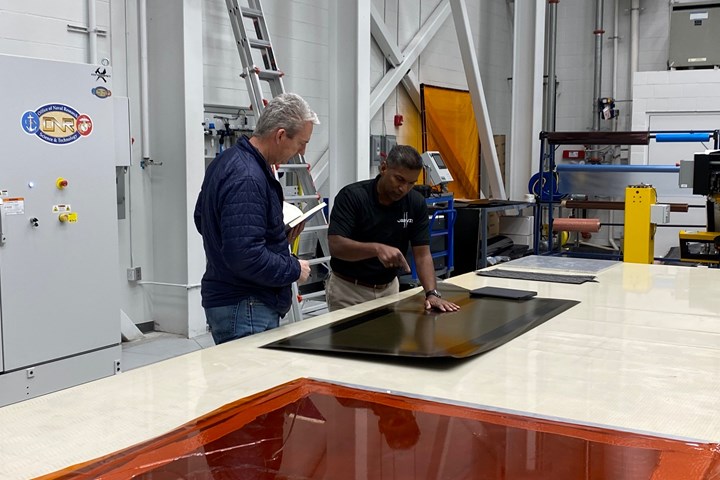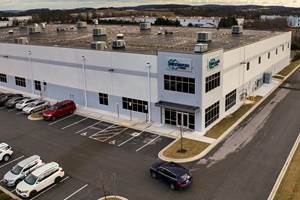CompositesWorld is on the road again
Since CW’s infancy, its editors have strived to imbue its coverage with a sense of place, whether that’s through plant tours, facility visits or trade shows. After a pandemic, this has never seemed more important.
Dr. Waruna Seneviratne, director – ATLAS at NIAR, offers CW editor-in-chief Jeff Sloan some pointers on composites manufacturing. Photo Credit: NIAR
A few weeks ago I was asked by someone I’d just met what I do for a living. I gave my standard answer and expected the standard reply — “Huh...” or “Oh...” — which I take to mean, “I’m not sure I understand what you just said.” But this time, I was surprised. The person I’d just met asked, “What is the one thing you’ve done as an editor of CompositesWorld that has been most impactful?”
No one has ever asked me this question, and for a moment I was struck with the type of anxiety that comes with a tough job interview (I challenge you to ask yourself the same question about your professional impact). So, I had to take a few seconds to think it over. My answer? “We go places,” I said, explaining that prior to my being hired in 2006, CW editors attended trade shows and conferences, but had no history of visiting the people (you) for whom we write. Once I joined, I wanted to imbue our coverage of the industry with a sense of place, and to use plant visits and tours as a way to help our audience understand how composite parts and structures are being designed, tooled, fabricated and finished.
Of course, during the pandemic we, like many of you, did not go many places. As COVID-19 vaccines rolled out in 2021 and a sort of normalishness returned, we were able, once again, to think about getting back out into the world. Other than trade shows and conferences, I have recently visited ATC Manufacturing (Idaho, U.S.), Bucci Composites (Italy), the National Institute for Aviation Research (NIAR, Wichita State University, Kansas, U.S.), Oribi Composites (Colorado, U.S.), AvCarb Material Solutions and Boston Materials (Massachusetts), and the Advanced Structures and Composites Center (ASCC, University of Maine, U.S.).
We are always on the lookout for people and places to visit.
Senior editor Ginger Gardiner has visited Victrex Composites Solutions (Rhode Island, U.S.), and Qarbon Aerospace (Georgia and Texas, U.S.). Associate editor Hannah Mason has visited Oak Ridge National Laboratories
and Magnum Venus Products (ORNL and MVP, Tennessee., U.S.), and Purdue University (Indiana, U.S.). We have published stories about many of these visits, and those we haven’t published yet are in the process of being written.
It was hard to know, before we started reconnecting with the industry in person, how the pandemic might have affected composites manufacturing in general. Although the sudden and dramatic reduction in commercial aerospace manufacturing had obvious negative impacts, we weren’t sure if or how the lockdown might affect innovation and creativity among material suppliers and fabricators. How could there not be a setback?
So, what have we found as we started visiting composites manufacturers again? My observation is that the pandemic not only failed to stifle innovation, but apparently created an environment in which it could flourish. That is, being confined to quarters allowed many fabricators to intensely focus on materials, technologies, projects and applications in a way that might have been challenging otherwise. I found that ATC, Bucci, Oribi, NIAR, AvCarb and Boston Materials were allowed to concentrate on technology developments that are already bearing fruit.
Ginger, for her part, says Victrex used the pandemic to prototype production runs of thermoplastic parts for advanced air mobility (AAM). The company also updated its materials and process simulations with tests after each project to increase accuracy and help speed future developments. Qarbon Aerospace maintained its aerostructures production while updating its production systems and infrastructure, preparing for the future growth it sees coming quickly in multiple markets. Both see thermoplastic composites as reaching a tipping point, and are maturing the technologies needed to achieve high-rate production.
Hannah notes that there’s been much opportunity for new R&D and creativity the last few years, including new consortia projects, startup companies and emerging technologies in composites recycling and other sustainability initiatives. And in automotive, creative solutions are hitting the market for composites in electric vehicles, especially in battery enclosures.
We are always on the lookout for people and places to visit. Let us know if your door is open.
Related Content
Hexagon Purus opens new U.S. facility to manufacture composite hydrogen tanks
CW attends the opening of Westminster, Maryland, site and shares the company’s history, vision and leading role in H2 storage systems.
Read MoreJEC World 2023 highlights: Recyclable resins, renewable energy solutions, award-winning automotive
CW technical editor Hannah Mason recaps some of the technology on display at JEC World, including natural, bio-based or recyclable materials solutions, innovative automotive and renewable energy components and more.
Read MorePolar Technology develops innovative solutions for hydrogen storage
Conformable “Hydrogen in a Box” prototype for compressed gas storage has been tested to 350 and 700 bar, liquid hydrogen storage is being evaluated.
Read MoreInfinite Composites: Type V tanks for space, hydrogen, automotive and more
After a decade of proving its linerless, weight-saving composite tanks with NASA and more than 30 aerospace companies, this CryoSphere pioneer is scaling for growth in commercial space and sustainable transportation on Earth.
Read MoreRead Next
“Structured air” TPS safeguards composite structures
Powered by an 85% air/15% pure polyimide aerogel, Blueshift’s novel material system protects structures during transient thermal events from -200°C to beyond 2400°C for rockets, battery boxes and more.
Read MoreAll-recycled, needle-punched nonwoven CFRP slashes carbon footprint of Formula 2 seat
Dallara and Tenowo collaborate to produce a race-ready Formula 2 seat using recycled carbon fiber, reducing CO2 emissions by 97.5% compared to virgin materials.
Read MoreDeveloping bonded composite repair for ships, offshore units
Bureau Veritas and industry partners issue guidelines and pave the way for certification via StrengthBond Offshore project.
Read More






















